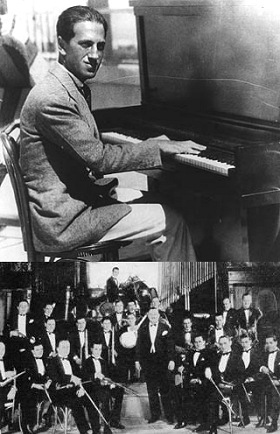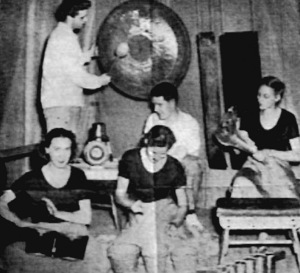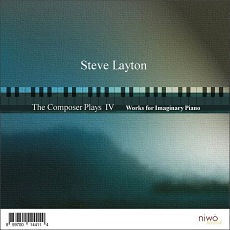(A little early this week, as I might be out on the weekend) …Our regular listen to and look at compositions and performances that you may not know yet, but I know you should… And can, right here and now, since folks are nice enough to offer so much good listening online. Time to sit in on a few “first moments” in musical history:
George Gershwin & Paul Whiteman : Rhapsody in Blue – Original 78rpm Acoustic Recording (1924)
 Made shortly after the premiere performance, and a year before the electric microphone came into use. The two records are on different pages: record one is here, and record two here. I can’t do any better than give B. Stockwell’s commentary from the Archive.org site:
Made shortly after the premiere performance, and a year before the electric microphone came into use. The two records are on different pages: record one is here, and record two here. I can’t do any better than give B. Stockwell’s commentary from the Archive.org site:
“This is an edited performance, with cuts made to fit the 15-minute work onto two 78-RPM discs. Total time is under 9 minutes, but the cuts are pretty smart ones. This work was originally written for a large dance band, the way you hear it here. This isn’t ‘Symphonic Jazz’. It’s authentic 1920’s style — completely different from the bloated ‘violins and cellos’ versions that we’re used to hearing. You can hear the banjos in this version. Gershwin plays the piano part and the performance is fast fast fast. The opening clarinet glissando wails and breaks off into reedy laughter. This is SO different from the the syrupy swooning you now hear. The sound isn’t spectacular — the microphone wasn’t invented until the next year, 1925 — but these 78s are still pretty well transfered. The recording of Rhapsody in Blue was a hit. In 1927 the same group — again with Gershwin but now with a microphone — made another recording. Paul Whiteman had a quarrel of some sort and walked out of the recording session. They recorded anyway, with another conductor — Nathaniel Shilkret, I think — taking over. Whiteman was happy to promote the recording as his own, nonetheless. The electric version is better recorded but it lacks, well, electricity. Everyone, including Gershwin, just punches it harder in 1924.”
———————–
Percussion Music from Lou Harrison’s Collection of 78rpm Acetate Records
 An absolutely fascinating audio document, this 1971 KPFA broadcast by Charles Amirkhanian presented extremely rare recordings of percussion music from the composer Lou Harrison’s (1917-2003) personal collection. Especially important are the acetate disks of a concert given by John Cage’s percussion ensemble at the Cornish School in Seattle on May 19th, 1939.
An absolutely fascinating audio document, this 1971 KPFA broadcast by Charles Amirkhanian presented extremely rare recordings of percussion music from the composer Lou Harrison’s (1917-2003) personal collection. Especially important are the acetate disks of a concert given by John Cage’s percussion ensemble at the Cornish School in Seattle on May 19th, 1939.
Cornish (still there and going strong; as a college student in 1978 I caught Cage himself at a tribute concert in the same hall, performing some of his Sonatas and Interludes) was where Cage found a job accompanying dancers, and it was there that he founded his first percussion ensemble and experimented with the prepared piano. (The stage in the Cornish performance hall was too small to accommodate all his percussion during a dance performance, so Cage came up with the idea of turning a single piano into its own percussion “ensemble”.) The performers heard include Cage, his then-wife Xenia, and the dancer Doris Dennison. (there has to be at least one more, quite possibly Lou Harrison himself. The photo here shows Lou, John, and Xenia behind, Doris and Margaret Jansen in front).
The pieces on these recordings represent the core of the West-Coast experimentalist group (I know, I know, Harry Partch; but he was off on his own very different journey): Lou Harrison’s Counterdance in Spring, Henry Cowell’s Pulse, two movements from Cage’s own Trio, Johanna M. Beyer’s Tactless and Endless, William Russell’s Three Cuban Studies, and again Harrison with his Fifth Simfony. You just can’t get much closer to sitting in on the roots of this exciting period.
The remainder of the broadcast features a 33rpm disk that captures a 1948 performance of Harrison’s Canticle #3, introduced and conducted by Leopold Stokowski during a concert at the Museum of Modern Art in New York City.
———————-
 On a personal note, I’ll mention the release of my own new CD, The Composer Plays IV: Works for Imaginary Piano, on the NiwoSound label. Along with my performance of Stravinsky’s Piano-Rag Music, the CD collects a number of my works that feature piano: either solo, doubled, or with recorded sound.
On a personal note, I’ll mention the release of my own new CD, The Composer Plays IV: Works for Imaginary Piano, on the NiwoSound label. Along with my performance of Stravinsky’s Piano-Rag Music, the CD collects a number of my works that feature piano: either solo, doubled, or with recorded sound.
Jumping into the first wave of what I’m sure is to become common practice, no physical copy of the CD will be offered for sale in stores; it will only be available to subscribers at both eMusic and iTunes (the link is to eMusic; the CD is not “live” on iTunes yet, but will be soon — not only in the US, but iTunes Europe, Canada, Japan and Australia as well. iTunes folks can simply search “Steve Layton” to find the complete list of my available CDs in their country). For those who want something in their hand to read, complete liner notes for the CD can be had as a free downloadable PDF file (300 kb) from my own website. Enjoy!

Greetings,
I am searching for studio, or live recordings (even stage remotes or airchecks)
of the Ted Harris Quartet. They held a regular Monday night performances at Ernie’s in Greenwich village throughout 1947, to interested crowds of jazz musicians. What is significant about this quartet is that they all studied shoenberg techniques of music composing and improvized on this. They would invent atonal melodic jazz phrases during msuci sessions. This of course we would call today Free Jazz, but 3 years before the famous 1949 experiments of Tristano. Indeed, historically significant recordings. They were members of the Local 802 Musicians Union, located at the time, in the Roseland Ballroom at 52nd St. & 7th Ave
They may have had airchecks made of them at that venue as well.
The quartet leader published some songs with the Fanfare Music Co. of Brooklyn, NY which your company presently owns.
The personnel were:
Ted Harris – Piano
Joe Maneri – tenor saxophone
Angelo Musolino – guitar
Aldo Lanfranco – drums
I had spoken to Joe Maneri, who named Ernie’s as the Greenwich club of historical interest.
If you have any information on live recordings, even airchecks, or local archivists who collect these period recordings, any help on this research would be greatly appreciated,
Adrian Delandro
Greetings,
You may have heard about the now famous Stuff Smith-Robert Crum 1944 apartment transcriptions that feature the two of them dipping into free improvisation. There are some nice examples on those recordings. What interests me is a comment made by Dr. Billy Taylor, a pianist who worked with Stuff Smith as a young studio protege around 1943-44. He made the observation that Smith and Crum would have after hours jam sessions at Stuff Smith’s Onyx jazz club in New York where Crum would play in a twelve tone manner on his piano and Smith would play quarter tones or ‘in between the notes’ in communication with Mr. Crum’s improvised piano figures. This would meet the criteria of the earliest free improvisation experiments. From the description it would seem there were no preconcieved themes, melodies, chord changes, or rythyms as the atonal method or 12 tone would rules these ideas out. If any air checks from Stuff Smith’s club exist from 1943-44 with the two of them experimenting, those sound documents have great hisorical value. If you, or someone has any information as to where these recordings may be, please forward it to me, or any contact information would be acceptable.
Thanks in anticipation,
Adrian Delandro
[…] Fellow Sequenza21 blogger Steve Layton, who recently put his own new album up on iTunes and eMusic, has some great comments to my original entry in which he compares the two services and provides some information on bit rates. […]
Steve, just got back from Arizona and read your post. Congratulations! Looking forward to downloading it. Of course there’s no real need for CDs anymore—and isn’t it better for the environment as well!
Congratulations on the new CD, Steve. Your note on niwo.com provided some great information for micro labels and self-starters. What CDBaby is doing is amazing right now. I heard that iTunes was actually reaching out to classical organizations to get their stuff up but I don’t know how easy it is to reach them if you’re a single composer with a single release.
I’ve been blogging about that dying CD at http://www.sequenza21.com/naxos with more on this coming up.
Aww, everybody is so nice to the new baby (and Joe, the new posters with beach shots in day-glo are just about ready 😉 …)
My only real credo is find a way to keep moving and making, and don’t let it sit in a drawer. Music’s all about being in somebody’s ear, right?. My own course may have taken a different turn from my “concert music” buddies, but my own ear tells me there’s an authetic experience in this path as well. Even when it’s “unreal”, keep it real, Dawg!
For those that might want to explore some of the newer paradigms for getting their music up and out there, I’ve penned a few thoughts on this latest move in independent recording, here:
http://www.niwo.com/steve/cds/forumpost_CD.html
No manifesto, just another very real possibility.
Steve:
I think your work relies too much on Beatlesque harmonies and four on the floor rhythmic patterns. Maybe this was fine for Lester Bangs and the staff at Creem & Crawdaddy but I cannot give praise for this type of audio Tom Foolery. Oh….I’m thinking of another Steve Layton!!!! As always Steve, a great piece of work. I’m a Layton Groupie (I have the posters up in my room). What I love about your music is that you are always moving forward and you never think about playing it safe. When I hear the first few notes, I know that it is Steve Layton. That is the highest praise I can pay to another artist. Thanks! Also…thanks for the Cage & company archival audio. Pretty fantastic music and pristine audio from a 78 in 39!
Good looking cover. Congratulations on creating the music and trying the new distribution paradigm. You are truly a 21st century composer.
Hey Steve, Congratulations on what looks like a wonderful new body of work (and an aesthetic that makes us think about alternative and exciting angles within the ritual of the music – making/sharing experience). I’ve enjoyed what I’ve heard/read from you before, and I really look forward to this!
You’re a self-made man, Mr. Layton. Bravo on the CD– what I know of your work is just marvelous!
Thanks, Tom. I figured since I made the pieces, made the performances, made the recordings and made the CD, I might as well make the cover art too…
Hey Steve,
Congratulations on the CD release; beautiful cover art by the way.